
duke : surfboard riding, part 1, 1911
| home | catalogue | history | references | appendix |
 |
surfresearch.com.au
duke : surfboard riding, part 1, 1911 |
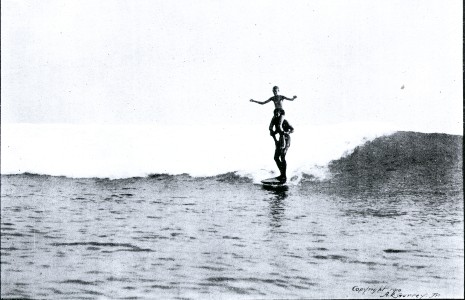 |
AT WAIKIKI BEACH, HONOLULU, TERRITORY OF HAWAII. Copyright 1910 A.R. Gurrey Jr. |
RIDING THE SURFBOARD
By DUKE
PAOA.
Duke Paoa
was born on the island of Oahu, within sound of the surf,
and has
spent half
of his waking hours from early childhood battling the
waves for sport.
He is now
21 years of age, and is the recognized native Hawaiian
champion surf rider.
Duke and
the members of the Hui Nalu, an organization of
professional surfers at Waikiki,
have
supplied the material for this article on the national
sport of Hawaii.
I have
never seen snow and do not know what winter means.
I have never
coasted down a hill of frozen rain, but every day of the
year, where the water is 76, day and night, and the waves
roll high, I take my sled, without runners, and coast down
the face of the big waves that roll in at Waikik!.
How would
you like to stand like a god before the crest of a monster
billow, always rushing to the bottom of a hill and never
reaching its base, and to come rushing in for half a mile at
express
speed, in
graceful attitude, of course, until you reach the beach and
step easily from the wave to the strand?
Find the
locality, as we Hawaiians did,- here the rollers are long in
forming, slow to break, and then run for a great distance
over a flat, level bottom, and the rest is possible.
Perhaps the
ideal surfing stretch in all the world is at Waikiki beach,
near Honolulu, Hawaii.
Here
centuries ago was born the sport of running foot races upon
the crests of the billows, and here bronze skinned men and
women vie today with the white man for honors in aquatic
sports once exclusively Hawaiian, but in which the white man
now rivals the native.
I mastered the art of riding the surf-board in the warm Hawaiian waters when I was a very small child, and I never gaze out upon the ocean in any part of the island that I do not figure out how far each wave, as it comes rolling in, would carry me standing on its crest.
There are great, long, regular, sweeping billows, after a storm at Waikiki that have carried me from more than a mile out at sea right up to the beach; there are rollers after a big kona storm that sweep across Hilo Bay, on the Big Island of Hawaii, and carry native surfboard riders five miles at a run, and on the Island of Niihau there are even more wonderful surfboard feats performed.
A surfboard
is easy to make.
Mine is
about the size and shape of the ordinary kitchen ironing
board.
In the old
days the natives were wont to use cocoanut logs in the big
surf off Diamond Head, and sometimes six of them ...
Page 4
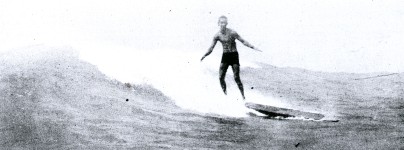 |
Among the
favorite pastimes of ancient Hawaiians that of surfriding
was a most prominent and popular one with all classes.
In favored
localities throughout the group for the practice and
exhibition of the sport, "high car- nival" was frequently
held at the spirited contests between rivals in this aquatic
sport, to witness which the people would gather from near
and far; especially if a famous surf-rider from another
district, or island, was seeking to wrest honors from their
own champion.
Native
legends abound with the exploits of those who attained
distinction among their fellows by their skill and daring in
this sport; indulged in alike by both sexes. Necessary work
for the maintenance of the family, such as farming, fishing,
mat and kapa making and such other house- hold duties
required and needing attention, by either head of the family
were often neglected for the prosecution of the sport.
Betting was
made an accompaniment thereof, both by the chiefs and the
common people.
Canoes,
nets, fishing lines, kapas, swine, poultry and all other
property were staked, and in some instances life itself was
put up as wagers, the property changing hands, and personal
liberty, or even life itself sacrificed, ...
(Photograph, page 4b, Headstand.)
Page 5
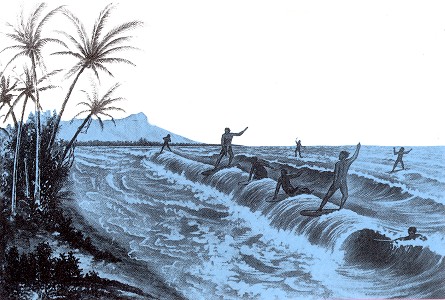 |
(Painting) This
tinted version from Anonymous
:
|
There were
only three kinds of trees known to be used for making boards
for surfriding, viz.: the wiliwili (Erythrina monosperma),
ulu, or bread-fruit (Artocarpus incisa), and koa (Acacia
koa).
The
uninitiated were naturally careless, or indifferent as to
the method of cutting the chosen tree, but among those who
desired success upon their lahors the following rites were
carefully observed:
Upon the
selection of a suitable tree, a red fish called kumu was
first procured, which was placed at its trunk.
The tree was
then cut down, after which a hole was dug at its root and
the fish placed therein, with a prayer, as an offering in
payment therefor.
After this
ceremony was performed, then the tree trunk was chipped away
from each side until reduced to a board approximately of the
dimensions desired, when it was pulled down to the beach and
placed in the halau (canoe house) or other suitable place
convenient for its finishing work.
Coral of the
corrugated variety, termed pohaku puna, which could be
gathered in abundance along the sea beach, and a rough kind
of stone called 'oahi, were the commonly used articles for
reducing and smoothing the rough surfaces of the board until
all marks of the stone adze were obliterated.
As a
finishing stain the root of the ti plant (Cordyline
terminalis), called mole ki, or the pounded bark of the
kukui (Aleurites moluccana), called hili, was the mordant
used for a paint, made with the root of burned kukui nut.
This
furnished a durable glossy black finish, far preferable to
that made with the ashes of burned cane leaves, or amau
fern, which had neither body nor gloss.
Before using the board there were other rites or ceremonies to be performed for its dedication, and, among those who followed the making of surf-boards as a trade, they were religiously observed.
There are
two kinds of boards for surfriding; one is called the olo
and the other the a-la-ia, known also as i omo.
The olo was
made of wiliwili- a very light, buoyant wood-some three
fathoms long, two to three feet wide, and from six to eight
inches thick along the middle of the board, lengthwise, but
rounding toward the edges on both upper and lower sides.
It is well
known that the olo was only for the use of the chiefs; none
of the common people used it. They used the a-la-ia, which
was made of koa, or ulu.
Its length
and width was similar to the olo, except in thickness, it
being but of one and a half to two inches thick along its
center.
The line of breakers is the place where the surf rises and breaks at ...
(Photograph,
page
5b, Four Boardriders, Diamond Head.)
The Real
Thing.
Page 6
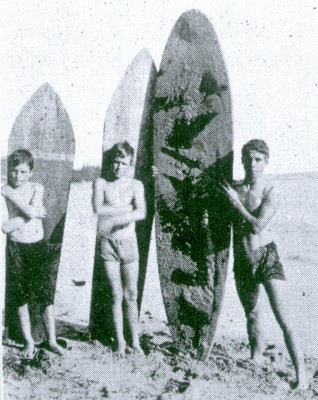 |
Surfboards |
There are
only two kinds of surf in which riding is indulged; these
are called kakala, known also as lauloa, or long surf, and
the ohu, sometimes called opuu.
The former
is a surf that rises, covering the whole distance from one
end of a beach to the other. This, at times, forms in
successive waves that roll in with high, threatening crest,
finally falling over bodily.
The first of
a series of surf waves usually partakes of this character,
and is never taken by a rider, as will be mentioned later.
The ohu is a
very small comber that rises up without breaking, but of
such strength that it sends the board on speedily.
This is
considered the best, being low and smooth and the riding
thereon easy and pleasant, and is therefore preferred by
ordinary surf-riders.
The lower
portion of the breaker is called honua, or foundation, and
the portion near a cresting wave is tremed the muku side,
while the distant, or clear side, as some have expressed it,
is known as the lala.
During calm weather, when there was 'no surf, there were two ",ways of making or coaxing it practiced by the ancient Hawaiians, the generally adopted method being for a swimming party to take several strands of the sea convolvulus vine and swinging it around the head lash it down unitedly upon the water until the desired result was obtained.
The
swimmer, taking position at the line of breakers waits for
the proper surf.
As before
mentioned, the first one is allowed to pass by.
It is never
ridden, because its front is rough.
If the
second comber is seen to be a good one, it is sometimes
taken, but usually the third or fourth is the best, both
from the regularity of its breaking and the foam calmed
surface of the sea through the travel of its predecessors.
In riding
with the olo or thick board, the board is pointed landward
and the rider, mounting it, paddles with his hands and
impels with his feet to give the board a forward movement,
and when it receives the momentum of the surf and begins to
rush downward, the skilled rider will guide his course
straight, or obliquely, apparently at will, according to the
spending character of the surf ridden, ...
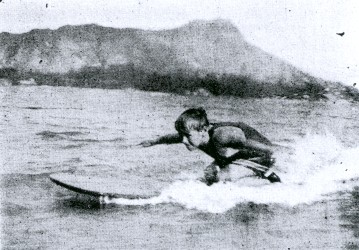 |
|
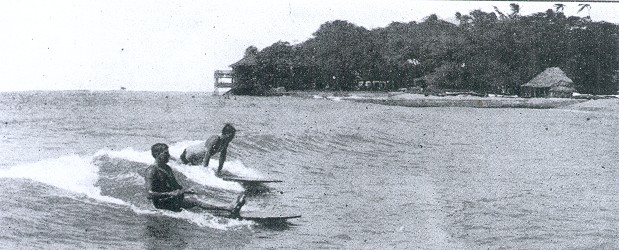 |
Taking It Easy. |
In the use
of the olo the rider had to swim around the line of surf to
obtain position, or be conveyed thither by canoe.
To swim out
through the surf with such a buoyant bulk was not possible,
though it was sometimes done with the thin boards, the
a-la-ia.
These latter
are good for riding all kinds of surf, and are much easier
to handle than the olo.
Kaha nalu is
the term used for surf- swimming without the use of the
board, and was done with the body only.
The swimmer,
as with a board, would go out for the position and, watching
his opportunity, would strike out with ha;nds and feet to
obtain headway as the approaching comber with its breaking
crest would catch him, and with his rapid swimming powers
bear him onward with swift momentum" the body being
submerged in the foam; the head and shoulders only being
seen.
Kaha experts
could ride on the lala or top of the surf as if riding with
a board.
I hope I
shall be forgiven if I quote ...
(Photographs,
page
7b, 7c, Diamond Head.)
In the Big
Surf.
Page 8
... largely from the writings of others, as I am not a writer myself, but know when I read a description of surfing whether or not it is correct.
Surfboard
riding is an art easy of accomplishment to the few and
difficult to the many.
It is at its
best when the rollers are long in forming, slow to break,
and, after they do, run for a great distance over a flat,
level bottom, such as the coral beds at Waikiki, which is
perhaps the all-year-round ideal surfboarding bit of water
in the whole world.
There are
three surfs at Waikiki: the "big surf" toward Diamond Head,
in front of Queen Liliuokalani's summer residence, where the
most expert surf-board riders and the native boys disport
themselves; the "canoe" surf, nearly in front of the Moana
Hotel, where the majority of those who stand on the board
dispute rights with the outrigger canoes that come sliding
in from a mile out at sea before the monster rollers; and
the beginners, or cornucopia surf - a series of gentle
rollers before the Outrigger Canoe Club's grounds and the
Seaside Hotel.
Here, as a
rule, beginners learn the art of balancing on the board.
The water
for several hundred yards out is but waist deep, so that the
malihini (new-comer) can stand beside his board, wait for a
wave, give his board a forward push, jump on, and race in
toward the beach before the foaming crest.
He quickly
learns, lying down, to guide the board by moving his legs,
like a rudder, from one side to the other.
There is
nothing difficult in mastering this portion of the art of
surfing, but out in the deep water it
is quite
another proposition.
There you
have no foothold from which to gain a start, which must now
be given the board by the power of the hands.
It is half a
mile out to the big waves, or "nalu nui," and a long "hoe,"
as the overhand windmill stroke that takes you out is
termed.
The
intending surfer launches his board by grasping it in both
hands by the edges, so that it balances, rushes down the
slightly sloping beach, and throws himself upon the board as
he casts it upon the waters with a forward movement that
gives it a good start and sends it beyond the first row of
little breakers.
Then begins
that constant, steady, windmill movement of the arms, the
hands acting as paddles, and the six or seven-foot plank of
light wood swiftly glides out to sea.
To the
beginner the exercise soon tires to exhaustion; the neck and
back ache, and the points of the ribs that touch the ...
(Photograph,
page
8b.)
Climbing
Up.
Page 9
... board
seem to cut through the flesh.
Perseverance,
however,
overcomes all obstacles, and after a few days new muscle is
developed and the stiffness is forgotten.
Out in the
deep surf, the board goes outward under the waves, a diving
tip being given the board just as it bucks each onrushing
breaker.
Once out
where the waves foam, the surfer sits on his board, which,
of course, sinks until only an inch or so of the tip is
above water, and waits for THE wave.
Several may
pass, then afar off he notices the one he wants.
It is coming
onward, a great green roller with a ridge of almost
imperceptible spray along its entire length.
This is the
wave that will curl and break to perfection, then rush on
for hundreds of yards - a Niagara of foam.
The line of
surfers prepares, and as the base of the mountain of water
reaches them, there is vigorous and deft paddling with all
the strength that skill can put into trained arms, and the
great effort is made.
Some rise
rapidly to the crest of the billow and sink behind it; they
have lost the wave.
Others keep
down in the hollow just before the wall of green.
It breaks,
and these fortunates are lost in the foam, rise through it,
standing on their board, are lifted to the top of the white
crest, and by skillful balancing, and guiding their boards
with their feet, send them down in the bias until once more
they are in front of the on-rushing mass of water.
Some of the
boards, of course, are divorced from their owners and go
sailing in the air, while the surfer dives involuntarily
toward coral.
Few,
however, are the accidents of surfing, and it is doubtful if
anyone has ever been seriously injured at this sport which
has come down to the "haole" from the old kings of Hawaii.
For several
years past the sport of surfing had been on the decline, for
as the vacant lots facing the beach at Waikiki were taken up
by private ownership, the small boy of Honolulu was forced
to give up his favorite sport.
It was on
account of this injustice to the small boy that the
Outrigger Club was formed in April, 1908.
The Club soon numbered several hundred members.
New members
were taught to ride standing upon the surfboard, and so
popular became the revival of the old Hawaiian sport that
even the ladies began to take a deep interest in it.
A number of
young girls have learned to stand upon their boards, riding
the waves, and together with their mothers and older sisters
have organized an auxiliary club.
Neither
surfboarding, nor driving the big native canoes safely
before the ...
(Photograph,
page
9b, Headstand.)
The
Crowning Stunt.
Page 10
 |
(Concluded in February Mid Pacific)
(Photograph, page 10b, Two riders.)
Page 133
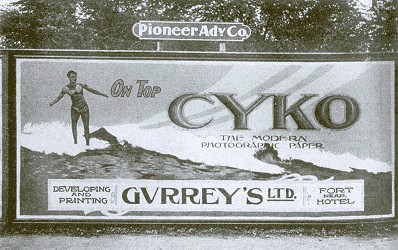 |
On
Top ... Developing
and Printing Reproduced in many subsequent editions. |
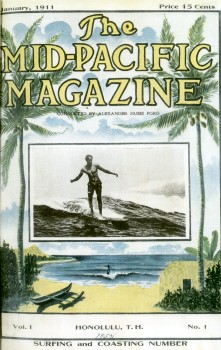 |
Volume 1, Number1. Published by Alexander Hume Ford, Honolulu, Territory of Hawaii, Volume 1, Number 1, January,1911. |
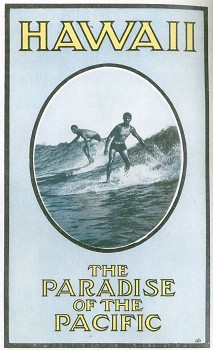 |
Published by Alexander Hume Ford, Honolulu, Territory of Hawaii, Volume 1 Number1. January,1911. Rear Cover. |

| home | catalogue | history | references | appendix |